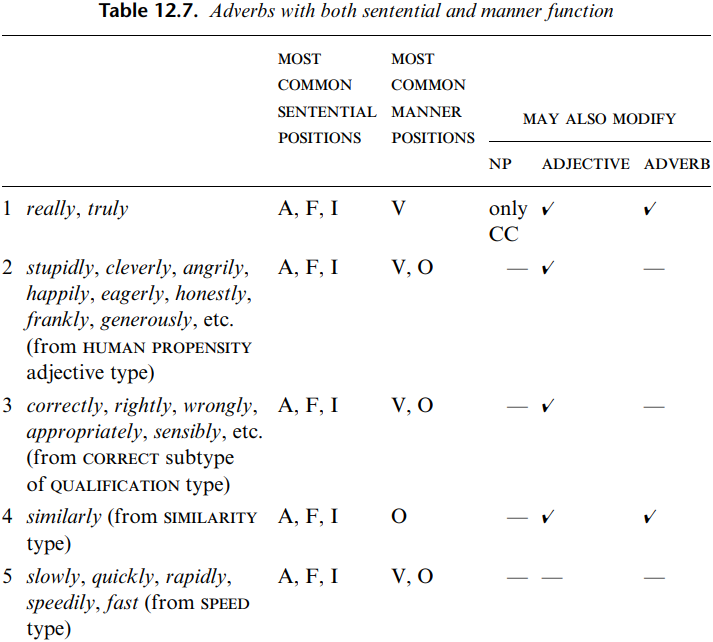


 Grammar
Grammar
 Tenses
Tenses
 Present
Present
 Past
Past
 Future
Future
 Parts Of Speech
Parts Of Speech
 Nouns
Nouns
 Verbs
Verbs
 Adverbs
Adverbs
 Adjectives
Adjectives
 Pronouns
Pronouns
 Pre Position
Pre Position
 Preposition by function
Preposition by function 
 Preposition by construction
Preposition by construction
 Conjunctions
Conjunctions
 Interjections
Interjections
 Grammar Rules
Grammar Rules
 Linguistics
Linguistics
 Semantics
Semantics
 Pragmatics
Pragmatics
 Reading Comprehension
Reading Comprehension|
Read More
Date: 2024-08-14
Date: 2024-07-14
Date: 2024-07-10
|
We summarized the properties of adverbs with both sentential and manner function, divided into five sets.

Set (1) involves really and truly, which were in row (h). These are the most omni-functional of adverbs. As illustrated for really, they have all five functions. In addition, they may modify an adverb-plus-adjective, or an adverb-plus-adverb. For example:

We frequently find these two adverbs coordinated, as one complex adverb; they are always in the order really and truly. For example, He really and truly believed me, and She is really and truly the most beautiful person I have ever seen.
Really and truly often modify an adverb from set (2), which may be repeated. Really or truly may then also be repeated. That is, one can say any of:

However, really (or truly) is not likely to be repeated unless the following adverb is; that is one would not expect to hear *really really very good. For very could be substituted terribly, awfully, etc.
All of the remaining sets involve adverbs derived from adjectives by the addition of -ly. The way in which stupidly occurs in sentential function at positions A, I and F and in manner function at positions V and O was already illustrated. Using stupidly in sentential function, as in (13a–c), implies that the soldier was stupid to answer the officer’s question, whereas using the adverb in manner function, as in (14a– b), implies that he answered the question in a stupid manner.
Set (2) covers adverbs derived from HUMAN PROPENSITY adjectives. Alongside stupidly we have cleverly, angrily, happily, eagerly and many others. In some contexts it is not easy to identify the different meanings these adverbs have in their sentential and manner functions. However, there always is an implied meaning difference, which can be brought out in an appropriate context. Consider happily, for instance. It is used in sentential function in (59a–c):

These sentences imply that the speaker is happy about John’s studying for the examination, without any implication that John is happy about doing this (he might be or he might not be). Now consider happily used as a manner adverb, in (60a–b).

These sentences state that John is studying in a happy mode.
Most adverbs retain the same meaning but just provide different kinds of modification when used in sentential and in manner functions. For example, sensibly means ‘it is sensible to do it’ in sentential and ‘it is done in a sensible way’ in manner function. But for some adverbs there is a slight meaning difference between the two functions. This was illustrated for quietly at (18a–b) and for honestly at (19a–b); it was there noted that frankly shows a similar difference.
Set (3) consists of adverbs from the CORRECT subset of the QUALIFICATION type of adjectives—correctly, rightly, wrongly, appropriately, and sensibly (mentioned in the preceding paragraph). These behave in a similar way to adverbs in set (2). For example, correctly could be substituted for stupidly in (13a–c)—stating that the soldier was correct to offer an answer to the question—and in (14a–b)—stating that he provided the correct answer. Adverbs from sets (2) and (3) may also modify an adjective (for example, stupidly anxious, appropriately diligent).
Set (4) consists just of similarly. This generally relates to something preceding in discourse. Suppose one person says Mary has been making a model. Someone else could reply, using any of:

Sentences (61a–c) state that John has been doing a similar thing to Mary, making a model. In contrast, (62) says that he has been making a model in a similar manner to Mary. It appears that, in manner function, similarly is restricted to position O. Similarly may also modify an adjective or an adverb; for example, similarly clever(ly).
The other items in the SIMILARITY semantic type do not pattern in this way. Differently simply functions as manner adverb in position O. Separately and independently function as manner adverbs in positions V and O. Adjectives like and unlike do not form adverbs since in modern English there already exist forms likely and unlikely with quite different meanings.
Set (5) involves adverbs derived from adjectives of the SPEED semantic type—slowly, quickly, rapidly, speedily and also fast (where adjective and adverb have the same form). These may occur in the three sentential and two manner positions. Of all the adverbs, these pose the most difficulty for perceiving distinct sentential and manner function senses. It seems that the manner positions are used to describe the speed of a volitional action; for example, She has been [(slowly) writing her memoirs (slowly)]. And the sentential positions may be preferred to describe the speed at which something happens; for example, (Slowly) she has (slowly) been gaining in confidence (slowly). These adverbs are unlikely to occur with LIKING verbs; and they do not easily modify adjectives or adverbs.
|
|
|
|
التوتر والسرطان.. علماء يحذرون من "صلة خطيرة"
|
|
|
|
|
|
|
مرآة السيارة: مدى دقة عكسها للصورة الصحيحة
|
|
|
|
|
|
|
نحو شراكة وطنية متكاملة.. الأمين العام للعتبة الحسينية يبحث مع وكيل وزارة الخارجية آفاق التعاون المؤسسي
|
|
|